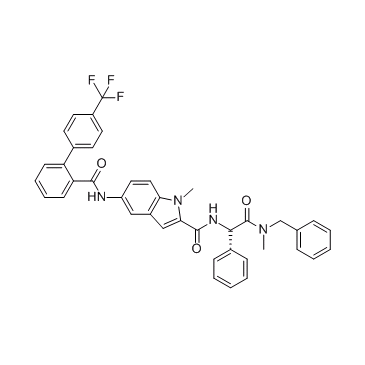| Description |
CV-159 is a unique dihydropyridine Ca2+ antagonist with an anti-calmodulin (CaM) action, and has antiinflammatory activities.
|
| Related Catalog |
|
| In Vitro |
CV-159 (0.1-10 μM) significantly inhibits TNF-α (10 ng/ml, 24 h)-induced VCAM-1 in SMCs in a concentrationdependent manner. CV-159 (10 μM, 30 min) significantly inhibits the TNF-induced ROS production[1]. CV-159 (10 μM) inhibits TNF (24 h)-induced expression of e-selectin but not vascular cell adhesion molecule-1 and intercellular adhesion molecule-1. CV-159 inhibits TNF (20 min)-induced phosphorylation of JNK, p38, and NF-κB p65 (Ser536)[2].
|
| In Vivo |
CV-159 (5 and 10 mg/kg, p.o.) gives significant protection against delayed neuronal death in the hippocampal CA1 region of the rats after 15-min transient forebrain ischemia. CV-159 also diminishes the size of the brain infarct after permanent middle cerebral artery (MCA) occlusion. CV-159 significantly reduces the increase in the water content of the infarcted cortex induced by MCA occlusion[3].
|
| References |
[1]. Usui T, et al. Mechanisms underlying the anti-inflammatory effects of the Ca2+/calmodulin antagonist CV-159 in cultured vascular smooth muscle cells. J Pharmacol Sci. 2010;113(3):214-23. Epub 2010 Jun 16. [2]. Usui T, et al. CV-159, a unique dihydropyridine derivative, prevents TNF-induced inflammatory responses in human umbilical vein endothelial cells. J Pharmacol Sci. 2010;113(2):182-91. Epub 2010 May 19. [3]. Miyazaki H, et al. Neuroprotective effects of a dihydropyridine derivative, 1,4-dihydro-2,6-dimethyl-4-(3-nitrophenyl)-3,5-pyridinedicarbox ylic acid methyl 6-(5-phenyl-3-pyrazolyloxy)hexyl ester (CV-159), on rat ischemic brain injury. Life Sci. 1999;64(10):869-78.
|
